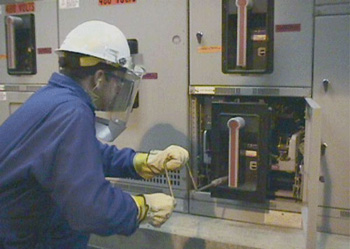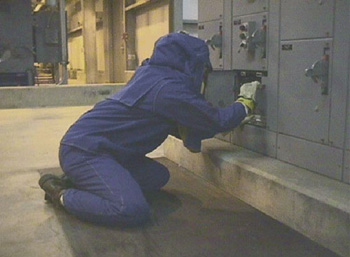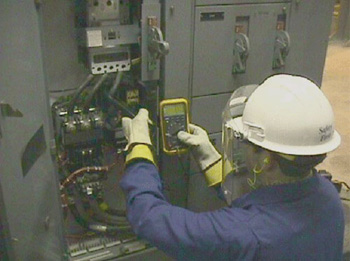The Hazards of Electricity
The electrical inspector and electrician are no different from any other craftsman. As they accumulate more experience and expertise in their field they begin to achieve a level of comfort with the tasks they perform on a regular and routine basis. Unfortunately, as the comfort level increases, the potential for complacency can begin to set in. In the electrical industry, there is no room for complacency. “Ordinary” and “routine” tasks, such as verifying voltage, taking current readings, and even visual inspection of live or energized parts, can subject the inspector and electrician to the multiple hazards of electricity.

Figure 1. A good job safety will help determine the appropriate PPE for the task.
For the past several years, an increasing amount of information has emerged concerning the multiple hazards of electricity. For many years, we assumed the electrical shock was the only hazard to be considered. Recent studies have shown that additional concerns must include the damaging effects of arc-blasts and arc-flashes. Consideration must be given to the devastating forces generated in arc-blasts when molten copper expands to 67,000 times its original value as it vaporizes. Likewise, arc temperatures can reach 35,000°F causing fatal burns at distances up to 10 ft and the pressure wave generated by the blast can reach upwards of 2,000 lbs/sq.ft., certainly enough pressure to rupture eardrums or even collapse the lungs. It is especially important to consider that as our electrical distribution systems continue to grow in size and capacity, the potential for higher and higher available fault currents and significantly greater arc-blasts and arc-faults rises sharply. For these reasons, electrical inspectors, electricians and anyone who works on or near energized circuits or equipment must be on constant guard that even the routine tasks they perform on a regular basis are done in a manner which affords the highest possible degree of personnel protection.
First Step: Are You Qualified?
The OSHA electrical safety-related work practices standard establishes guidelines for both the “qualified” person and the “unqualified.” Unfortunately, the OSHA General Industry, Electrical Standards, give very little direction in determining and defining what skills are necessary to be considered “qualified.” Fortunately, NFPA 70E-1995, Standard for Electrical Safety Requirements for Employee Workplaces defines a qualified person in Section 2-2.1. as one “trained and knowledgeable of the construction and operations of equipment or a specific work method, and be trained to recognize and avoid the electrical hazards that might be present with respect to that equipment or work method. Such persons shall also be familiar with the proper use of special precautionary techniques, personal protective equipment, insulating and shielding materials, and insulated tools and test equipment. A person can be considered qualified with respect to certain equipment and methods but still be unqualified for others.” As a first step, employers should evaluate all employee’s skills to determine if they have the necessary knowledge and training to perform work on or near energized electrical circuits and equipment. Those that have inadequate training or knowledge must maintain minimum approach distances in the direction of live parts to ensure their protection. At a minimum they should be trained in and be very familiar with proper approach distances for unqualified persons.
De-energize First

Figure 2. Potential high energy and available fault currents require specialized PPP.
To protect electricians and other workers exposed to the hazards of electricity, the Occupational Safety and Health Administration (OSHA) established guidelines which must be followed to protect against the damaging effects of electricity. In general, these are referred to as “Electrical Safety-Related Work Practices.” These work practices were originally developed under direction from OSHA in NFPA 70E, Standard for Electrical Safety Requirements for Employee Workplaces. In general, both NFPA 70E and OSHA 1910 Subpart S, Electrical Standards require electrical circuits and equipment to be de-energized before work is performed on or near them. Note that “de-energized” is defined as being placed into an electrically safe work condition by locking out and tagging the circuit and equipment. For circuits 50-volts and above, work is not permitted to be performed on or near live parts unless the employer can demonstrate that de-energizing the circuit or equipment introduces additional or increased hazards or is infeasible due to equipment design or operational limitations. Note that the definition of “infeasible” does not include considerations such as cost or convenience. Infeasibility is intended to apply to equipment operational limitations. For example, measuring voltage or taking current readings is not possible with the circuit or equipment de-energized and would require that the task be performed with the circuit in an energized condition. Too often, accidents occur when electricians fail to de-energize or request that circuits be de-energized first. Typically, accident reports indicate that work was performed in an energized condition because it would have been “inconvenient” or would have cost too much to de-energize the circuit or equipment.
Working Hot

Figure 3. Routine tasks, such as current readings, require appropriate PPE.
When the employer demonstrates that it would create an additional or greater hazard or it is infeasible to de-energize the circuit, other safety-related work practices must be employed to protect workers when work on or near energized circuits or equipment must occur. These safety related work practices vary with the specific task and hazards associated with the job and must be suitable for the conditions under which the work is to be performed and for the voltage level of the exposed electric conductors or circuit parts. Typically they may include, the use of all necessary personal protective equipment, insulating blankets, shields or barriers, insulating tools and protective clothing. These provisions apply to all circuits and equipment which operate at 50-volts and over. Because of the multiple hazards associated with this type of work, a complete job safety analysis should be completed before performing the work. This analysis should include careful consideration of the specific hazards associated with the task. The proper selection of the appropriate safety-related work practices and personal protective equipment is determined from this analysis.
Conclusion
Unfortunately, many electricians today fail to follow or completely adhere to the OSHA regulations and NFPA 70E recommendations. Instead, they choose to ignore the minimum safety-related work practices and fail to utilize proper personal protective equipment. Frequently, electrical workers and other personnel who work on or near energized electrical circuits and equipment, without the necessary PPE become statistics, highlighting the dangers associated with electrical work. A decision to work circuits and equipment in an energized condition should only be made after a determination has been made that it would be infeasible or that it would create a greater hazard to de-energize. Once that demonstration has been made, a job hazard analysis should be performed to evaluate all of the possible hazards associated with the tasks. The specific safety-related work practices, personal protective equipment and insulating tools necessary for the task should be apparent after the job hazard analysis is complete. Finally, a job briefing should be conducted prior to beginning the task to ensure that each of the employees involved with the task understand his or her responsibilities and the hazards associated with those responsibilities.










Find Us on Socials